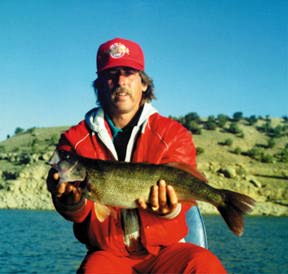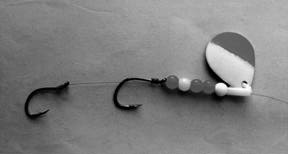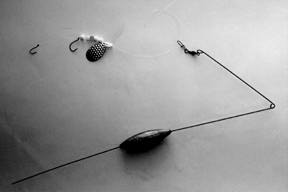See all of our walleye fishing articles.
By Kent Erickson

Utah’s walleye sport fishery has increased dramatically in recent years and currently includes a half dozen reservoirs that contain an abundance of the marble-eyed predators.
So many fish, so much structure … so little time!
If you want to increase your walleye fishing time to almost year-round trolling and learn the structure in your favorite lakes, then bottom bouncing is the answer. Bottom bouncing reduces the time it takes to find these nomads of the deep, improves your fishing, and increases your knowledge of walleye’s habits. This highly effective trolling method makes it possible to cover large areas of water in a minimum amount of time to locate actively feeding walleye and to trigger reactions from neutral or inactive fish. Once you locate fish, you can concentrate your time at the depth or contour that the fish are occupying.
As the name implies, bottom bouncing keeps the bait on or near the bottom, in the walleye’s strike zone. At the same time it also keeps your lure or bait out of the snags, which maximizes your time in the water.
Basic Equipment
 The equipment needed to go bottom-bouncing is simple. While your equipment does not need to be expensive it should be durable and in good condition. The best rod and reel combination I can suggest is a 7 foot medium heavy bait casting rod that has plenty of backbone for handling snags and up to four ounces of weight, and a fast tip for finesse hook sets and for fighting large fish. A medium sized bait casting reel that will hold at least 100 yards of 12 pound test line and that has with a flippin’ switch works best. The flippin’ switch allows you to let out line using only one hand, which aids immensely in reacting to increases in depth while trying to follow the bottom with your weight.
The equipment needed to go bottom-bouncing is simple. While your equipment does not need to be expensive it should be durable and in good condition. The best rod and reel combination I can suggest is a 7 foot medium heavy bait casting rod that has plenty of backbone for handling snags and up to four ounces of weight, and a fast tip for finesse hook sets and for fighting large fish. A medium sized bait casting reel that will hold at least 100 yards of 12 pound test line and that has with a flippin’ switch works best. The flippin’ switch allows you to let out line using only one hand, which aids immensely in reacting to increases in depth while trying to follow the bottom with your weight.
Two items of equipment that, while relatively expensive, are becoming more and more popular on fishing boats are a sonar and an electric trolling motor. I learned how to bottom bounce without these luxuries, but only because I fished from a 12 foot aluminum boat with a 9.5 hp gas motor. Once I picked up a 48 pound thrust electric motor and a sonar, my bottom bouncing world changed dramatically. A sonar (either LCD or flasher) allows you to watch the changes in bottom depth so you can react in time to keep your bottom bouncer from snagging a boulder or weed bed. It also allows you to "see" the bottom so you can keep your boat and fishing line at the proper depth contour. This will keep you in the strike zone. The electric motor gives you more exact speed control, which can be critical at times when walleye require a slow presentation to get them to bite. As an added bonus, the electric trolling motor is much quieter and reduces the "spook factor," especially when trolling in shallow, 2 to 10 foot water.
The Bottom Bouncer and Rig
 Very simple in design, a bottom-bouncer is made of stiff wire shaped like a "7" with a weight formed onto the vertical leg about halfway up. The leg is normally 12 inches long, which keeps a trolled rig 6 to 12 inches off the bottom. The weight can be one half ounce or less up to four ounces, but for most situations in Utah a two ounce bottom bouncer is just the ticket. You can fish the rig from two to 20 feet deep and keep in contact with bottom while trolling .5 to 3 miles per hour. The leader for the rig or lure attaches to a swivel at the tip of the "7." The rig or lure may be a spinner rig, a live bait rig with no spinner, a soft plastic imitation, or a crankbait. The main line attaches to the bottom bouncer at the angle of the wire.
Very simple in design, a bottom-bouncer is made of stiff wire shaped like a "7" with a weight formed onto the vertical leg about halfway up. The leg is normally 12 inches long, which keeps a trolled rig 6 to 12 inches off the bottom. The weight can be one half ounce or less up to four ounces, but for most situations in Utah a two ounce bottom bouncer is just the ticket. You can fish the rig from two to 20 feet deep and keep in contact with bottom while trolling .5 to 3 miles per hour. The leader for the rig or lure attaches to a swivel at the tip of the "7." The rig or lure may be a spinner rig, a live bait rig with no spinner, a soft plastic imitation, or a crankbait. The main line attaches to the bottom bouncer at the angle of the wire.
The quality of the line, swivels, and hooks you use and the condition you keep them in are important factors when rigging bottom bouncers. New, tough, 10 to 12 pound test line on your reel is a good choice for rigging walleye, especially for fishing in the rocks. Good quality #7 swivels will handle the snags and heavy weights beautifully. Perhaps the most overlooked tackle item is the hook. When you consider that the success of the entire endeavor involves getting the hook to set and hold, a sharp, high quality hook is a must. Use proven, quality hooks and check them often. Sharpening or replacing them when necessary will pay off in more fish. As for hook size, #6,#4, and #2 octopus style hooks are great for spinner rigs, with #4 best for all around use.
A spinner rig consists of a strong leader (10 to 16 pound test) that has one, two, or three hooks connected. Above the hooks are five or six brightly colored beads or a brightly colored float topped off with a clevis which holds the spinner blade. When trolled, the spinner blade creates vibration, noise, and flash in front of the bait to attract the walleye.
A size 2 to 4 blade is commonly used, but blades up to a size 7 or 8 can come in handy sometimes. Colorado blades catch more water and work better for slower speeds, and Indiana blades work better when moving faster. Orange, chartreuse and combinations of the two are the workhorse colors, but silver, brass and other colors can work well at times.
Although minnows, leaches, and plastics can be used on the hooks, a nightcrawler is typically used for bait, which gives rise to yet another name for a spinner rig—a worm harness. Unless a dead minnow is used (using live minnows for bait is illegal in Utah), you will want two or three hooks to harness the crawler. Run the front hook through the tip of the head of the crawler. Then "stretch" the nightcrawler before the second and third hook is inserted so it will troll straight with no loops or sags.
How to Troll Bottom Bouncers
Now for the meat of the matter—technique. Although bottom bouncing can be refined to an art form in terms of technique and various presentations, the basics of trolling bottom bouncers are simple, easily learned, and almost instantly rewarding.
Typically, walleye feed at a particular depth on particular structure. It is critical to maintain that depth when walleye are found, and equally critical to stay on the structure without unnecessary snagging or dragging. It all boils down to boat control and rod control.
Bottom bouncing is a hands-on endeavor. Many walleye anglers fail to have success when bottom bouncing because their rig is either too high up off the bottom (at least they don’t snag) or laying on its side, constantly dragging across the bottom (*@!!# snags). When you first let out line and touch bottom, your line goes slack, then tightens up. You need to let out a little more line, tap-tap with the rod to find bottom, a little more, tap-tap with the rod, and repeat until you can feel the bottom on each tap, but not the constant drag of the weight across the bottom. A bottom bouncer’s effectiveness and snag resistance depends on correctly tapping, or "bouncing," the sinker along the bottom. When just the wire below the weight comes in contact with bottom the lure or bait trolls just above the bottom and the weight resists hanging up in rocks and other snags. Now you are set until the bottom drops off or rises a few feet or more. By watching the sonar you can anticipate these changes and reel in or let out line or raise or lower your rod tip to compensate.
The next problem will be when you feel your rig snag. This is normal. Don’t feel defeated. Simply point your rod towards the snag and jerk straight up. Do not jerk the pole toward the front of the boat . You will be doomed to turn back to get it out—a waste of time.
Now the good part, the hook set. When you feel a walleye hit your line, don’t haul off and put your back in the hook set like you would for a trout. It’s a hard habit to break but after you miss a few you will settle down and practice the dip and sweep. When you feel the fish, feed it to him (dip the rod back), then firmly sweep you pole forward and the battle is joined.
Boat control is the number one most important factor when bottom bouncing for walleye. As mentioned before, walleye concentrations are found on particular structure at a particular depth. That means if you can’t keep the boat on the structure, (such as the top of a hump, the edge of a ledge or a shoreline contour), and at the proper depth, then you won’t succeed in catching walleye while bottom bouncing. By using the sonar, by watching the shoreline to help imagine what the bottom looks like, by paying attention to the wind and waves, and by watching where your rig is in relation to the boat, you can properly concentrate your fishing effort where the fish are. You must also realize that turns create speed changes on the outside lines (increase) and inside lines (decrease), which puts those lines deeper or shallower. Pay attention to these changes and control your boat properly and your fishing success will increase proportionately.
How good of a method is bottom-bouncing for catching lots of walleyes, including the big ones, in Utah’s walleye waters? The 1998 Utah Walleye Circuit tournament results answers that question best. Local bottom-bouncer teams won all four tournament events as well as three out of the four big fish competitions! Average weights went as high as 3.7 pounds per fish and the monsters stuck on rigs weighed between 6.02 pounds and 9.86 pounds! Not too shabby. The results are a great example of just how effective that the ol’ B-bouncin’ riggin’ can be.
No matter what level of expertise you have, bottom bouncing is a proven, effective fish finder and a big catch producer. If you just stick to the basics, anyone from six to sixty can do it and come home with a big smile, a sore arm, and a load of big fish stories.

